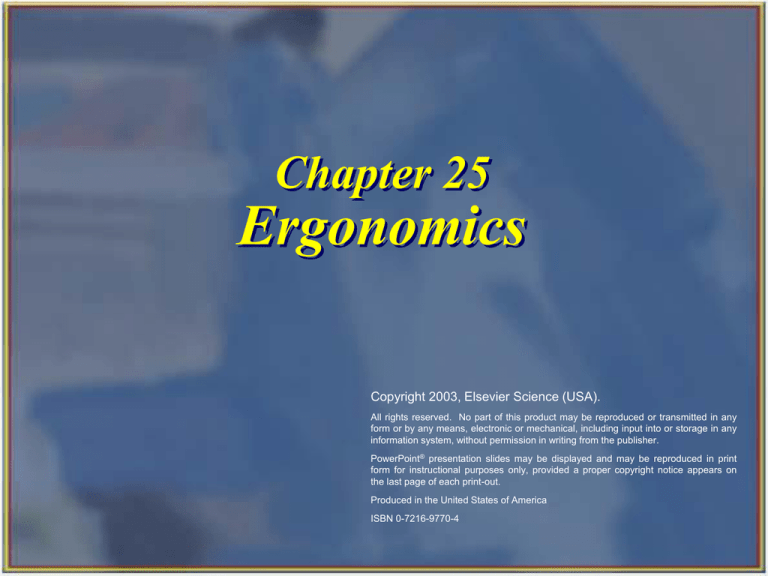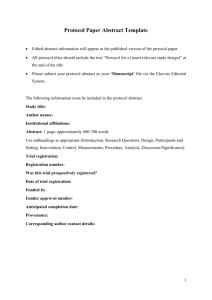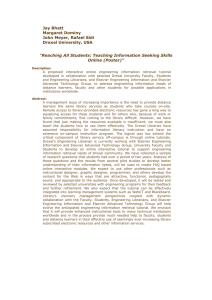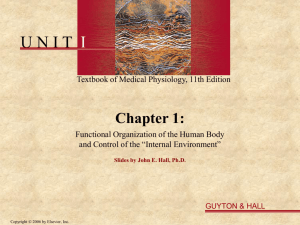
Chapter 25
Ergonomics
Copyright 2003, Elsevier Science (USA).
All rights reserved. No part of this product may be reproduced or transmitted in any
form or by any means, electronic or mechanical, including input into or storage in any
information system, without permission in writing from the publisher.
PowerPoint® presentation slides may be displayed and may be reproduced in print
form for instructional purposes only, provided a proper copyright notice appears on
the last page of each print-out.
Produced in the United States of America
ISBN 0-7216-9770-4
Introduction
Ergonomics deals with adaptation of the human body to the
work environment.
Ergonomic conditions are simply the safest, most efficient,
and easiest way to work.
The word “ergonomics” comes from the Greek words
“ergon” (work) and “nomos” (laws of work).
The goal of ergonomics is to help people stay healthy and at
the same time perform their work more effectively by
changing the design of the workplace, instruments, systems,
products, training, or some combination of these elements.
Copyright 2003, Elsevier Science (USA). All rights reserved.
Fig. 25-1 Ergonomic factors in dentistry.
Fig. 25-1
Copyright 2003, Elsevier Science (USA). All rights reserved.
Musculoskeletal Disorders
Headaches, neck and shoulder pain, back pain, and
carpal tunnel (wrist injuries) account for many
disabling and potentially career-ending
musculoskeletal disorders for dental professionals.
Work habits, posture, and equipment and
instrument design can contribute to these workrelated disorders.
Copyright 2003, Elsevier Science (USA). All rights reserved.
Ergonomics in the Dental Office
Members of the dental team usually perform their work
in a seated position, often use excessive motions, and
have unbalanced postures.
Work-related musculoskeletal disorders can range from
back pain, joint pain, neck and shoulder pain, hand
and wrist pain, and headaches.
The early onset of pain should alert you that an
imbalance exists, and if ignored, more serious damage
can occur over time.
It is important for the dental assistant to understand
how to implement ergonomic changes and methods to
prevent material safety data sheets (MSDS).
Copyright 2003, Elsevier Science (USA). All rights reserved.
Risk Factors
There are three interrelated factors that contribute
to increased risk of job-related injury. These are:
• Posture
• Repetition
• Force
Copyright 2003, Elsevier Science (USA). All rights reserved.
Posture
Posture affects the ability of the dental assistant to
reach, hold, and use the equipment.
It also influences how long the dental assistant can
perform a task without suffering adverse health
effects.
Over time, any position will eventually become
fatiguing and may lead to lower back pain.
Consider alternating assisting at chairside with
other dental assistants in the office to give each
other some variety in positions.
Copyright 2003, Elsevier Science (USA). All rights reserved.
Posture- cont’d
Establish a neutral position by sitting upright with your
weight evenly distributed.
Your legs should be separated with your feet flat on the
chair footrest.
Your back should be pressed against the back of the
chair for lumbar support.
Your hips should lean forward to rotate the pelvis
backward. The properly aligned spine resembles a gentle
“S.”
When the spine is properly aligned, the ears, shoulders,
and hips are in straight vertical alignment, providing
balance, support, and equal distribution of weight.
Copyright 2003, Elsevier Science (USA). All rights reserved.
Posture- cont’d
While assisting the dentist, there is a tendency for
the dental assistant to deviate from the neutral
position.
Examples of such deviations include leaning
forward, twisting, overbending the back, and
reaching.
These poor postures can lead to aches, pains,
numbness, and tingling. Ideally, alternate sitting
and standing whenever possible.
Copyright 2003, Elsevier Science (USA). All rights reserved.
Fig. 25-2 The dental assistant should sit on a chair with a lumbar support,
not on a stool.
Fig. 25-2
Copyright 2003, Elsevier Science (USA). All rights reserved.
Reaching, Twisting, and Stretching
Frequent reaching, twisting, and working with the
arms in awkward positions can cause strains and
sprains.
Extreme stretching of muscles or ligaments causes
strains, and sprains usually involve a sudden twist
or wrenching of a joint with stretching or tearing of
ligaments.
Shoulder problems can be caused by repeatedly
reaching behind the body for instruments or
supplies.
Copyright 2003, Elsevier Science (USA). All rights reserved.
Reaching, Twisting, and Stretchingcont’d
Keep the air-water syringe, handpiece, saliva
ejector, and high-volume oral evacuator so that
they are within a “normal horizontal reach.”
Keep the operatory light within a safe “maximum
vertical reach.”
Other supplies used less frequently should be
placed within the “maximum horizontal
reach.”
Reaching behind your back and lifting can cause
shoulder injury. When turning is necessary, rotate
the chair rather than twisting your body.
Copyright 2003, Elsevier Science (USA). All rights reserved.
Repetition and Force
Repetitive motion, overflexing, and extension of
the wrist can significantly increase the risk of
cumulative trauma disorders (CDTs),
particularly when the task requires force.
To help prevent CDTs, it is recommended to take
periodic breaks and alternate difficult procedures
with less stressful procedures. A common CTD is
carpal tunnel syndrome.
Copyright 2003, Elsevier Science (USA). All rights reserved.
Fig. 25-3 Small pieces of equipment should be in a position that does not
require twisting or bending.
Fig. 25-3
Copyright 2003, Elsevier Science (USA). All rights reserved.
Carpal Tunnel Sydrome
The carpal tunnel refers to an anatomic area of the
hand/wrist.
With improper motions, the tendons swell and exert
pressure on the median nerve.
The first symptoms of carpal tunnel syndrome (CTS) is
a painful tingling in one or both hands.
A decreased ability and power to squeeze objects or
make a tight fist may follow.
In advanced cases, the thenar muscle (located at the
base of the thumb) may weaken, causing a feeling of
decreased strength in the hand grip.
Copyright 2003, Elsevier Science (USA). All rights reserved.
Fig. 25-5 A, Cross section of wrist. B, Schematic view of the carpal tunnel
(samples attached).
Fig. 25-5
Copyright 2003, Elsevier Science (USA). All rights reserved.
Fig. 25-4 The bend in the wrist can lead to carpal tendon injury over long
period.
Fig. 25-5
Copyright 2003, Elsevier Science (USA). All rights reserved.
Carpal Tunnel Sydrome- cont’d
Other repetitive hand and wrist movements such as
knitting, gardening, or keyboard use can also cause
CTS.
The use of ambidextrous gloves (gloves that are worn
on either hand) can place excessive tension on the
thenar eminence (the fleshy elevation of the palm
side of the hand) by forcing the hand to work against
the vertical alignment of the glove form.
Right-left gloves that are properly sized support the
hand in a natural position, which properly positions
the thumb, index finger, and middle finger.
Copyright 2003, Elsevier Science (USA). All rights reserved.
Fig. 25-6 Gloved hand showing hypothenar eminence.
Fig. 25-6
Copyright 2003, Elsevier Science (USA). All rights reserved.
Body Strengthening Exercises
Stretching and strengthening the muscles that
support the back and neck and those used in the
forearm, wrist, and hand will help them remain
strong and healthy.
You can do periodic stretching throughout the
workday.
Before beginning any exercise program, you should
check with your physician, particularly if you
experience pain with any of the movements.
Copyright 2003, Elsevier Science (USA). All rights reserved.
Hand Exercises
Resting hands frequently is believed to be one
of the most important factors in preventing CTS.
Use the following exercises to stretch and relax
the muscles in the hand.
Copyright 2003, Elsevier Science (USA). All rights reserved.
Fig. 25-7 A and B, Slowly open and close your hands from a completely open position to
a completely closed position, which ends with your fingers tucked into your palm.
Fig. 25-7 A & B
Copyright 2003, Elsevier Science (USA). All rights reserved.
Fig. 25-7 C, Press the palms of your hands together and then relax them.
Fig. 25-7 C
Copyright 2003, Elsevier Science (USA). All rights reserved.
Fig. 25-7 D, Gently pull and relax each finger on each hand separately.
Fig. 25-8 D
Copyright 2003, Elsevier Science (USA). All rights reserved.
Fig. 25-7 E, Cross the wrists and gently stretch and relax.
Fig. 25-7 E
Copyright 2003, Elsevier Science (USA). All rights reserved.
Eye Exercises
To relieve eyestrain caused by focusing intensely
at one depth of vision for long periods, look up
from the task and focus your eyes at a distance
for approximately 20 seconds.
Practice this frequently throughout the day to use
your full range of vision and lessen eyestrain.
Copyright 2003, Elsevier Science (USA). All rights reserved.
Back Exercises
To relieve stresses placed on the back, neck, and
shoulders, try the full back release.
Let the head move down slowly and allow the arms
and head to fall between the knees; hold for a few
seconds, then raise slowly by contracting the
stomach muscles and rolling up. Bring the head up
last.
Copyright 2003, Elsevier Science (USA). All rights reserved.
Fig. 25-8 Full back release.
Fig. 25-8
Copyright 2003, Elsevier Science (USA). All rights reserved.
Neck Exercises
Try head rotations for neck stiffness. Head
rotations involve tilting the head from right to
left, as well as forward and backwards, without
forcing the motion beyond a range of comfort.
Copyright 2003, Elsevier Science (USA). All rights reserved.
Shoulder Exercises
Shoulder shrugging can be used to stretch the
shoulder muscles that may be stressed from
holding oral evacuators, instruments, and
telephone handsets. Pull the shoulders up toward
the ears, roll them backward and then forward in a
circular motion.
Copyright 2003, Elsevier Science (USA). All rights reserved.
Fig. 25-9 Shoulder shrugging.
Fig. 25-9
Copyright 2003, Elsevier Science (USA). All rights reserved.






